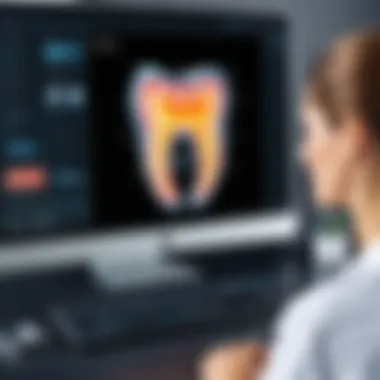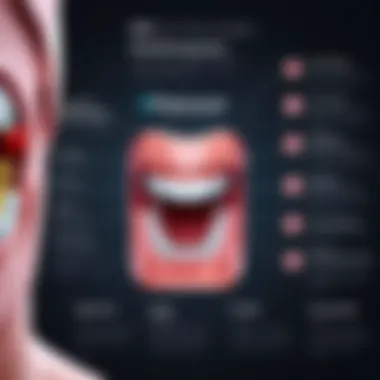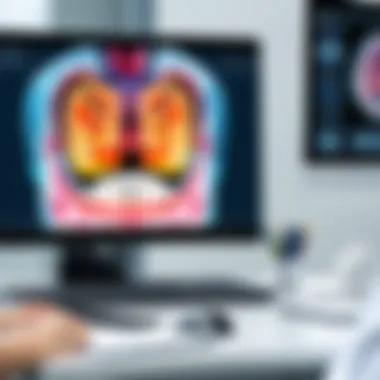Top Dental Imaging Software: A Comprehensive Guide


Intro
In the realm of dental healthcare, precise imaging solutions are critical. They aid professionals in diagnosing various dental conditions with greater accuracy. This underscores the importance of selecting the right dental imaging software, which can profoundly impact patient care and practice efficiency. Analyzing the existing options provides valuable insights into their capabilities, user experiences, and integration potential within dental practices. This article aims to guide decision-makers in choosing the software that aligns best with their operational needs and clinical goals.
Key Features and Functionalities
Comprehensive Overview
Dental imaging software has evolved significantly, incorporating advanced technologies to improve accuracy and efficiency. Modern solutions often feature:
- 3D Imaging Capabilities: Allows for comprehensive visualization of oral anatomy.
- Enhanced Image Quality: High-resolution images contribute to better diagnosis.
- Intuitive User Interface: Simplifies navigation and operational processes for practitioners.
- Integration Options: Seamlessly connects with other dental practice management systems.
Different products may offer specialized functions, adapting to various workflows within clinics. The capabilities to process images quickly and accurately are paramount in environments where time and precision are essential.
Target Users
Understanding who utilizes dental imaging software can inform better product choices. Primary users include:
- Dentists and Oral Surgeons: Require reliable imaging for diagnosis and treatment planning.
- Dental Hygienists: Use imaging for preventive care and patient education.
- Practice Administrators: Need efficient software for managing patient records and billing.
- Radiology Specialists: Focus on image interpretation and analysis.
By acknowledging the diverse user base, developers can tailor their offerings to meet specific needs, helping to streamline workflows across dental practices.
Pricing Models and Cost Analysis
Breakdown of Pricing Tiers
Dental imaging software can come with various pricing structures. Common models include:
- Subscription-Based Pricing: Monthly or annual fees to access software, accommodating changes in practice size.
- One-Time Licensing Fees: Payment for lifetime usage, often accompanied by additional charges for updates and support.
- Per-Use Fees: Charges based on the number of images processed, suitable for smaller or sporadic practices.
These pricing strategies cater to different practice sizes and workflows, ensuring flexibility in financial planning.
Additional Costs to Consider
While evaluating solutions, practitioners should be mindful of hidden costs:
- Training expenses for staff to ensure effective use of software.
- Hardware upgrades required for optimal software performance.
- Ongoing support and maintenance fees.
Considering these factors leads to more informed decisions and greater long-term value.
"A thorough evaluation of software costs can prevent budget overruns and enhance overall effectiveness in practice."
Ultimately, understanding the key features and pricing models of dental imaging software can significantly impact the decision-making process within dental practices. This ensures that professionals select the most suitable solutions for their needs, ultimately enhancing patient care and operational efficiency.
Prologue to Dental Imaging Software
Dental imaging software plays a crucial role in modern dentistry. With technological advancements, practitioners now rely heavily on accurate imaging to make informed diagnostic decisions. This software not only enhances the quality of diagnostic images but also facilitates better patient management and overall practice efficiency. Therefore, understanding the scope of dental imaging software is vital for both dental professionals and organizations.
Understanding Dental Imaging
Dental imaging encompasses various techniques and technologies used to visualize the structures of the teeth, gums, and surrounding tissues. The most common forms of dental imaging include X-rays, CT scans, and digital radiography. Each method presents unique advantages in terms of detail and visualization, which can greatly affect diagnosis and treatment planning.
As a core component of oral health, imaging helps in identifying issues such as cavities, bone loss, and infections, which are often not visible during a standard examination. The importance of precise imaging cannot be overstated. Enhanced imaging quality leads to improved detection rates and, ultimately, better patient outcomes.
The Role of Software in Dental Imaging


The integration of advanced software into dental imaging has transformed the landscape significantly. This software is designed to enhance the clarity and resolution of images while also providing intuitive user interfaces that simplify the interpretation of complex imaging data.
Here are some of the roles software plays in the domain of dental imaging:
- Improves Image Clarity: Dental imaging software optimizes images for better clarity, allowing dentists to observe details that may influence treatment plans.
- Facilitate Collaboration: Many software solutions allow for the sharing of images and reports within dental teams, improving communication and coordinated care.
- Supports Digital Workflow: As dental practices move towards digitalization, these tools ensure seamless integration with other systems such as electronic health records.
- Data Management and Storage: Effective software solutions enable secure storage and easy retrieval of imaging data, essential for ongoing patient management.
Moreover, software can streamline routine tasks, minimizing the potential for human error. Rather than relying solely on traditional methods, the software's analytical capabilities can enhance a dentist's diagnostic confidence.
In today's rapidly evolving dental environment, embracing sophisticated imagery software is not just beneficial; it is essential for delivering high-quality patient care and staying competitive in the market.
Key Features of Dental Imaging Software
The significance of key features in dental imaging software cannot be overstated. These features determine how effectively a software solution meets the unique needs of dental practices. They can impact efficiency, diagnostic accuracy, and ultimately, patient care. In this section, we will dissect the core attributes that practitioners should consider when evaluating dental imaging software, highlighting their benefits and potential implications.
Image Quality and Resolution
One of the foremost considerations in any imaging software is image quality and resolution. High-quality images enable dental professionals to make detailed assessments. This capability helps in identifying conditions that may not be visible to the naked eye. Clear images play a vital role in treatment planning as they allow for more precise diagnoses. When selecting software, practitioners should look for options that support high-resolution formats and advanced imaging techniques, such as 3D rendering. This ensures the best possible visual representation of dental structures.
User Interface and Accessibility
The user interface and accessibility of dental imaging software greatly affect user experience. A clean and intuitive interface can significantly reduce the learning curve for dental practice staff. When the software is easy to use, it allows staff to focus on patient care rather than grappling with complex technology. Additionally, accessibility features are crucial. These include compatibility with devices like tablets and smartphones, allowing for remote access to images and reports. Ensuring that the software can be used by all team members, regardless of their technical skill levels, enhances overall productivity in the office.
Integration with Other Systems
Integration capabilities are essential for seamless practice management. Effective dental imaging software should interface smoothly with other systems, such as electronic health records (EHR), practice management solutions, and billing software. Compatibility reduces data entry duplication and minimizes the chance of errors. Furthermore, it can lead to a more cohesive workflow when different software tools collaborate effectively. Practitioners should check for software solutions that offer comprehensive APIs or existing integrations with popular systems. This can significantly enhance operational efficiencies and patient interactions.
Report Generation and Analytics
Finally, robust report generation and analytics tools are vital features of dental imaging software. These tools should provide detailed reports from imaging data, offering insights that go beyond the visual aspect. For example, software that includes analytics can help track patient histories and treatment outcomes. This capability allows for better performance measurements and aids in identifying trends within a practice. When selecting software, consider solutions that not only generate standard reports but also offer customizable options for in-depth analysis. This can be beneficial for strategic planning and improved patient management.
"High-quality images enable dental professionals to make detailed assessments essential for diagnosing and planning treatments effectively."
Popular Dental Imaging Software Solutions
In the modern dental landscape, imaging software solutions play a crucial role. These tools enhance diagnostic capabilities, improve workflow efficiency, and enable better patient management. Selecting the right dental imaging software is paramount for dental practices as it directly influences clinical outcomes and patient satisfaction.
Dental imaging software offers various benefits, such as:
- Streamlined Processes: Efficient imaging reduces time spent on manual tasks, allowing practitioners to focus more on patient care.
- Higher Accuracy: Advanced imaging software improves the clarity and detail of images, aiding in precise diagnosis and treatment planning.
- Integration with Systems: Many popular software solutions can integrate with practice management and electronic health record systems. This integration facilitates seamless information sharing and enhances overall practice management.
- User-Friendly Features: Easy navigation and intuitive interfaces are critical for efficient use, especially in fast-paced clinical environments.
Consideration of compatibility with existing hardware and other essential systems should not be overlooked. Practices must evaluate their needs and available features carefully. The following sections will discuss prominent dental imaging software solutions and their respective attributes, focusing on their overview and key features.
Software A: Overview and Features
Software A is renowned for its advanced imaging capabilities and user-friendly interface. This solution provides high-resolution images crucial for accurate diagnostics. The software supports a variety of imaging modalities, including 2D and 3D imaging.
Key features of Software A include:
- High-Quality Imaging: Delivers detailed images that assist in detecting dental conditions early.
- Integration Options: Easily integrates with other dental systems, ensuring a cohesive workflow.
- Customizable Reports: Offers customizable reporting features, making it easy for practitioners to generate detailed case studies.
Software B: Overview and Features
Software B has gained popularity for its robust analytical tools and streamlined workflow. This software excels in patient management, allowing for efficient appointment scheduling and follow-ups.
Highlighted features include:


- Intuitive Workflow Design: Simplifies the imaging process from acquisition to analysis.
- Real-Time Collaboration: Enables multiple users to access images and collaborate on cases instantly.
- Mobile Compatibility: Provides mobile applications for access on-the-go, enhancing flexibility for dental professionals.
Software C: Overview and Features
Software C distinguishes itself with innovative x-ray imaging technology. This software focuses on enhancing patient safety through minimized radiation exposure.
Core features are:
- Radiation Reduction Technology: Helps reduce the amount of radiation patients receive during imaging.
- Enhanced Image Processing: Advanced algorithms improve the quality of images post-acquisition, ensuring clarity.
- User Training Resources: Comprehensive training materials help new users adapt to the software efficiently.
Software D: Overview and Features
Software D is widely recognized for its comprehensive suite of tools that cater to a variety of dental imaging needs. This software supports both traditional and digital imaging, making it versatile for practices transitioning to digital methods.
Notable features include:
- Versatile Imaging Support: Compatible with various imaging types, ensuring flexibility.
- Comprehensive Analytics Dashboard: Offers insightful data on patient imaging over time.
- Customer Support Services: Provides strong customer support to assist users in troubleshooting and resolving issues quickly.
Overall, these software solutions represent significant advancements in dental technology. Selective integration of these tools can substantially enhance clinical performance and patient experiences in dental practices.
Pros and Cons of Leading Software
In the exploration of dental imaging software, understanding the pros and cons of leading solutions becomes crucial. This section provides insights into the strengths and weaknesses of specific software options, which assists dental professionals and decision-makers in making informed choices. By weighing the benefits against potential drawbacks, users can align software capabilities with their practice’s needs and patient care objectives.
Advantages of Software A
Software A stands out for several reasons. Firstly, it offers exceptional image quality and resolution, allowing practitioners to view diagnostic images in high detail. This can significantly enhance treatment planning and patient education.
Additionally, its user interface is intuitive, which minimizes the learning curve for new users. Moreover, the software integrates seamlessly with various practice management systems, streamlining workflows and increasing efficiency. The robust analytics features allow for detailed reporting, making it easier for dental teams to track patient outcomes over time. With these features, Software A provides an all-in-one solution to improve clinical outcomes and organizational effectiveness.
Disadvantages of Software A
Despite its advantages, Software A is not without limitations. The initial cost of acquisition can be a barrier for smaller practices. Ongoing subscription fees and upgrade costs also contribute to an expensive overall investment. Additionally, some users report that customer support can be slow in addressing technical issues, leading to frustration when immediate assistance is required. These factors need careful consideration against the software's benefits.
Advantages of Software B
Software B also presents a strong case with its highly customizable settings. This flexibility allows dental practices to tailor the software functionalities to their specific workflows. Furthermore, the software supports multiple imaging modalities, enabling comprehensive diagnostic capabilities.
Its cloud-based storage offers ease of access to patient data from different locations, which is particularly beneficial for practices with multiple sites. Positive feedback on its user-friendly mobile application illustrates how it enhances real-time data entry and accessibility for dental professionals on the go.
Disadvantages of Software B
However, Software B has its disadvantages as well. Users have reported occasional connectivity issues, particularly in areas with weak internet signals. Furthermore, the customization options, while advantageous, can be overwhelming for some users who may prefer a more straightforward interface. Additionally, handling large files can slow down the system performance, which might affect workflow efficiency during peak hours.
In summary, both Software A and Software B offer unique advantages and drawbacks. Careful analysis of these factors is essential for practices to select the software that aligns with their needs and resources.
User Experiences and Testimonials
User experiences and testimonials play a pivotal role in assessing dental imaging software solutions. They provide insights beyond mere specifications and marketing claims. Clinicians and office managers often rely on firsthand accounts to evaluate effectiveness, usability, and integration within existing workflows. Collecting this kind of feedback helps highlight the real-world performance of software, uncovering both strengths and weaknesses that may not be evident during a software demonstration.
In the context of dental imaging, the quality of imaging software can significantly impact diagnostic accuracy and patient satisfaction. When users share their experiences, it illuminates specific functionalities, such as image clarity, ease of use, and compliance with regulations. Such reviews are invaluable for decision-makers looking to invest in systems that will enhance their practice while maintaining high standards of patient care.
Feedback on Software A
Feedback on Software A is a mix of enthusiastic endorsements and cautious criticism. Many users praise its intuitive interface, making navigation a breeze even for those less tech-savvy. The software enables quick access to all necessary features, significantly reducing the learning curve for new staff. High-quality imaging capabilities are frequently mentioned, with specific highlights on how it enhances diagnostic precision, especially in complex cases.


However, some testimonials indicate that initial setup can be time-consuming. Users have reported challenges in seamlessly integrating Software A with their existing Practice Management Systems. The support team has received mixed reviews; while some users claim prompt assistance, others feel that responses could be more timely. The overall sentiment remains positive, but potential buyers are advised to consider training and integration needs upfront.
Feedback on Software B
Software B has also garnered a variety of opinions. Users often commend its robust reporting features and customizable options. The software is noted for generating detailed analytics that help practitioners track treatment outcomes and patient progress effectively. Many users report that these capabilities lead to improved communication with patients, helping them understand their treatment journey better.
On the downside, some reviews point out that Software B can be resource-intensive, requiring more powerful hardware to run smoothly. Users have expressed concerns regarding system updates, noting that they sometimes disrupt daily operations. Moreover, difficulties in accessing customer support during peak hours have been mentioned, suggesting that response times could become problematic during busy practice periods.
Common Issues Reported
Despite the overall effectiveness of various dental imaging software, users have reported several common issues across different platforms. These include:
- Interoperability Problems: Difficulty in integrating with other systems or platforms remains a significant concern. Users often find that software does not communicate well with electronic health records.
- High Operational Costs: Many users cite concerns over licensing fees and ongoing maintenance costs, which can strain budgets.
- Lack of Training Resources: Several practitioners feel inadequate resources for training staff exist, leading to inefficiencies.
- Software Bugs: Occasional reports about bugs or crashes during peak usage times have been observed among some products.
The Future of Dental Imaging Software
The evolution of dental imaging software is not just an ongoing trend; it is a critical shift that underpins advancements in dental practices globally. As technology continues to accelerate, understanding the future of this software becomes paramount for stakeholders in the dental industry. The integration of advanced technologies is a key factor driving innovations. Emerging technologies such as artificial intelligence, augmented reality, and cloud computing are expected to reshape how dental imaging is conducted. These advancements open up new possibilities in diagnostic accuracy and workflow efficiencies.
Additionally, there are significant benefits to be gained from these technologies. They not only improve the quality of images produced but also enhance the overall user experience. Furthermore, the growing emphasis on patient-centered care necessitates software solutions that prioritize accessibility and seamless patient interaction.
One of the primary considerations is the future-proofing of dental practices. As software continues to evolve, so too must the systems in place at dental clinics. Decision-makers need to assess current platforms and their capacity for integration with new technologies. This understanding will ensure they remain competitive in a rapidly changing landscape.
Emerging Technologies
Emerging technologies are fundamentally transforming dental imaging software. One influential technology is artificial intelligence (AI). AI enhances image analysis, allowing for quicker and more accurate detection of dental issues. Software that incorporates AI algorithms can provide diagnostic support that was once the domain of skilled professionals alone. This reduces human error and improves treatment planning due to more precise data.
Augmented reality (AR) is another game-changer. By overlaying images directly on patients during diagnostics, AR facilitates real-time decision-making. This capability allows dentists to visualize treatment options comprehensively, leading to more informed and precise patient care.
Moreover, the adoption of cloud computing within dental imaging platforms is rising. This shift enables practitioners to store, share, and retrieve images efficiently. Cloud-based systems also support remote consultations, making access to expert opinions easier for complex cases. The implications for tele-dentistry are significant, expanding the reach of dental care to underserved regions.
Predictions for Industry Growth
The dental imaging software market is poised for growth on multiple fronts. Industry analysts predict an increase in market size due to rising demand for advanced imaging solutions. The enhanced capability for diagnoses and treatment planning is likely to be a primary driver.
In particular, growing awareness of the benefits that sophisticated imaging technologies bring to patient care will fuel this growth. Clinics that adopt advanced software will gain a competitive edge through improved service delivery and patient satisfaction. They're not merely adopting new tools; they're paving the way for a more data-driven and patient-focused approach to dental health.
Additionally, market expansion will also be influenced by regulatory changes promoting technological adoption. As regulations evolve to support new technologies, practitioners will be encouraged to integrate these systems into their practices. This dynamic will cultivate innovations that will define the dental imaging landscape in the years to come.
"The intersection of technology and dental imaging is not just about improvement. It is about transforming the very fabric of patient care across the globe."
The End and Recommendations
In summary, the exploration of dental imaging software is essential for any dental practice aiming to enhance its diagnostic capabilities and patient care. As technology evolves, so too do the tools available for dental professionals. By understanding the key features, user experiences, and future trends in dental imaging software, decision-makers can make informed choices that align with their specific needs and practice goals.
When considering dental imaging software, it is important to weigh several factors. The first is image quality and resolution. High-quality images are critical for accurate diagnoses. Additionally, a user-friendly interface significantly affects day-to-day operations in a busy practice environment.
Another consideration is the ability to integrate with existing systems. Software solutions should seamlessly connect with practice management tools and electronic health records. This integration not only saves time but also reduces errors that can impact patient care.
From our analysis, the advantages and disadvantages of each software solution should be carefully evaluated. Some software may excel in certain features but lack in others. Therefore, it is wise to prioritize the attributes that matter most for your practice.
"Choosing the right dental imaging software is not just about features, but also about enhancing patient interactions and outcomes."
Key Takeaways
- Importance of Image Quality: Focus on software that provides high-resolution images for better diagnosis.
- User Experience Matters: A software with an accessible interface can greatly improve efficiency.
- Integration is Key: Look for solutions that integrate well with other systems in your practice.
- Balance Pros and Cons: Thoroughly evaluate the advantages and disadvantages of software options.
Final Thoughts on Software Selection
Selecting dental imaging software warrants thoughtful consideration. It's not merely about the immediacy of a solution but the long-term impact on your practice. Each dental office has unique requirements, making personalized evaluation critical.
When discussing features, remember that the best software will align with your workflows while enhancing the quality of patient care. Keep abreast of emerging technologies and be prepared to adapt as innovations become available. Ultimately, the choice of software should enhance not only the efficiency of your operations but also the trust and satisfaction of your patients.















